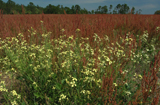Fall Allergies
Managing Seasonal Allergies
Many people start to think about seasonal allergies as fall approaches. Although allergies are often associated with the spring, plants, molds, and dust mites produce allergens during the fall as well—known as hay fever.
Also called seasonal allergic rhinitis, hay fever causes sufferers to sneeze, have a runny nose, and have an itchy nose, throat, and eyes. These allergies can start as early as August and last for several months.
Common Fall Triggers
- Ragweed: Ragweed is the one of the biggest fall allergy triggers. Ragweed has greenish-yellow flowers that bloom in late summer. These flowers produce a lot of pollen, which is carried by the wind and can travel up to 700 miles.
- Cedar Elm: Cedar Elm is commonly planted along streets and parking lots. The trees are relatively low maintenance and tolerate alkaline and wet soils, but the flowers produce pollen that contributes to fall allergies.
- Molds: Molds are fungi that can be found anywhere and their spores can travel through the air. Because Florida is a warm state, mold can be found year-round.
Treating Seasonal Allergies
Recognize your allergy triggers and try your best to avoid them. This could include limiting pollen exposure, keeping your home dust-free, and using air conditioning in your home and car. Be aware that pollen can come into your home through open windows and doors. Keep track of pollen and mold counts to avoid exposure.
It's also good to get treatment before the fall allergy season starts. Treatment can include over-the-counter products such as nasal sprays, pills, and rinses, or prescription pills and allergy shots from your physician.
Although you don't need a prescription for over-the-counter drugs, speak with your doctor about these medications as some can make symptoms worse or have side effects. Additionally, seek medical attention if your medications aren't relieving allergy symptoms, your sense of smell or vision changes, you have frequent sinus infections, your nose is constantly congested, or your allergy problems are disrupting your sleep.
Visit Gardening in a Minute for more information and fall-allergy resources.
Adapted and excerpted from:
K. Griesmann, “Fall Allergies: Tiny Pollen Grains, Big Allergy Problems,” Duke Health (Accessed 08/2013).
A. Lamborn, “Ragwood vs. Goldenrod: Clearing the Confusion For Allergy Sufferers,” UF/IFAS Extension Baker County (Accessed 10/2014).
“Freedom from Fall Allergies,” UCF Health Services blog (Accessed 10/2014).
“Outdoor Allergens: Tips to Remember,” American Academy of Allergy Asthma & Immunology (Accessed 10/2014).
"Ulmus crassifolia, Cedar Elm," UF/IFAS Landscape Plants (rev. 08/2014).

Related Sites & Articles
- UF/IFAS Publications
- Spring Winds Move Oak Pollen (pdf)
- UF/IFAS Sites
- Fall Allergies
- Ragweed
- Landscape Plants: Cedar Elm
- Other Sites & Publications
- Pollen & Spore Levels: South Atlantic--American Academy of Allergy, Asthma & Immunology

